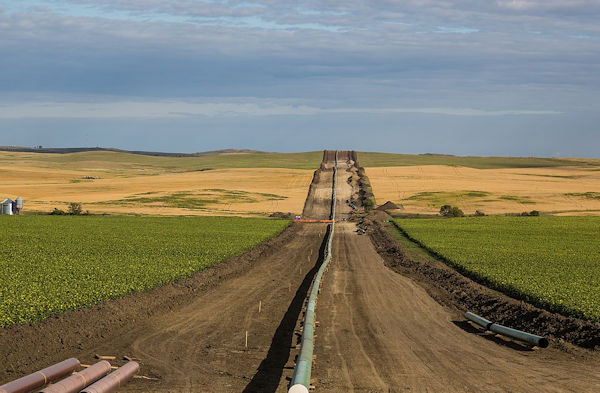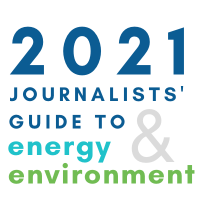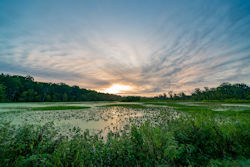SEJournal Online is the digital news magazine of the Society of Environmental Journalists. Learn more about SEJournal Online, including submission, subscription and advertising information.
 |
|
Gas and oil pipelines have been generating lawsuits for much of the past decade and will likely do so again in 2021. Above, the Dakota Access Pipeline being installed in New Salem, North Dakota, in 2016. Photo: Tony Webster, Wikimedia Commons. Click to enlarge. |
Issue Backgrounder: Environmental Issues Likely To Find Their Way to Courts in 2021
EDITOR'S NOTE: This story is one in a series of special reports from SEJournal that looks ahead to key issues in the coming year. Visit the full “2021 Journalists’ Guide to Energy & Environment” special report for more.
By Joseph A. Davis
 |
If parks and prairies are one kind of landscape environmental journalists cover, there’s another they might be traversing in the months and years ahead — that is, the legal landscape.
One thing you can expect in the coming year, and, in fact, through the years of the Biden administration, is legal conflict over Biden administration undoing of Trump administration rollbacks of environmental protection rules.
The epic list of environmental rollbacks under the Trump administration has already generated a new crop of lawsuits. While only a few have yet to reach the Supreme Court, a good many may still do so if they can first run the gauntlet of lower courts newly fortified with judges backed by Senate Majority Leader Mitch McConnell (R-Ky.)
Another thing the Biden camp has already signalled clearly will be efforts to expand and extend historical laws and missions to embrace environmental goals. For instance, Biden’s declared intention to make climate a priority at almost all executive agencies will surely spark a few lawsuits.
The courts may turn out to be one of
the most decisive environmental arenas
for the incoming Biden administration.
In the end, the courts may turn out to be one of the most decisive environmental arenas for the incoming Biden administration. Since many Trump rollbacks, challenged by environmentalists in cases still undergoing trial or appeal, have been defended in court by the Trump Justice Department’s environmental lawyers, Biden’s environmental top brass could simply drop those cases, withdrawing them or asking for them to be sent back to executive agencies. This sort of thing happened, in reverse, at the beginning of the Trump administration.
In any case, make no mistake: On the environmental beat, litigation matters. A case in point is Massachusetts v. Environmental Protection Agency. That momentous decision, handed down by the Supreme Court in 2007, opened the way for the EPA to start regulating greenhouse gases under the Clean Air Act. It was also the foundation of much of the Obama administration’s program for combatting climate change. But while it’s supposedly considered settled law, newly emboldened conservatives may yet challenge this doctrine before the current court.
So as the Biden administration replaces Trump’s and as a new conservative majority on the Supreme Court starts hearing cases, it’s worth taking stock of big legal conflicts playing out in the courts at all levels.
The number and complexity of the coming year’s environmental cases are too huge to describe neatly. But here are some general areas where you will see a lot of conflict — and news.
➤ Trump rolls back climate rules
Remember the fight against climate change? Obama tried and failed to get a climate bill through the Senate, so he used his executive power (under Mass. v. EPA) to issue a regulation known as the Clean Power Plan, which was promptly challenged in court by a group of red-state attorneys general led by Oklahoma’s Scott Pruitt.
Once Pruitt became EPA administrator, he withdrew the Clean Power Plan and used rulemaking to put forth his own Affordable Clean Energy plan, which industry liked more. That was promptly challenged in court by some 23 blue-state AGs (among other parties in various suits). And that cluster of cases is mostly still pending and unresolved. Enter Biden.
➤ Clean Water Act scope on wetlands
Another long Jarndyce v. Jarndyce-type legal conflict has been over the scope of the nation’s main water pollution law — the Clean Water Act, or CWA.
 |
| Wetlands in McKee Beshers Wildlife Management Area, Maryland. Photo: Danielle Brigida, Flickr Creative Commons. Click to enlarge. |
We will not bore you long with the multi-century history of this conflict. But just know that during the 1800s, the federal role on waterways was exercised mainly by the Army Corps of Engineers, which kept “navigable waters” open to shipping by removing snags, sandbars and random trash. When the Clean Water Act was upgraded in 1972, Congress was building on a preexisting notion of jurisdiction over “waters of the United States,” or WOTUS. For decades, Section 404 of the CWA was used to regulate destruction of wetlands by requiring permits to dredge or fill wetlands.
Then two Supreme Court decisions, in 2001 and 2006, tried to redefine that jurisdiction, but left everything more muddled than before. In 2015 the Obama administration tried to clear things up via rulemaking — giving us the “Clean Water Rule,” which interpreted the CWA’s WOTUS scope broadly, to include wetlands and intermittent streams.
The agriculture and real estate lobbies, which did not like wetlands permits, objected again. So the Trump-Pruitt EPA repealed the Obama rule and issued its own “Navigable Waters Protection Rule.” This drastically narrowed the scope of waters that EPA could protect from pollution. And it begat a whole new generation of lawsuits, most of which are still unresolved. Look for Biden rulemaking and more lawsuits.
➤ Push, pull over NEPA
The National Environmental Policy Act of 1970, or NEPA, is a foundational environmental law. To put it simply, it requires agencies to study and report on the environmental impact of their major actions, even when those actions are administrative (like issuing a permit). It also requires these findings to be published in environmental impact statements, or EISs, which are subject to public comment.
Reporters often love NEPA because EISs are wellsprings of information. Industry groups often hate them because environmentalists can sue, claiming that the government did not adequately consider environmental impacts. The Trump administration — and its patrons in the energy industry — also often hate them because they require agencies to consider the climate change impacts of their actions.
The Trump administration in July 2020 changed the rule (may require subscription) implementing NEPA, weakening it in a number of ways. One was to do away with the requirement that agencies consider the climate change consequences of their actions. More than 20 states promptly sued EPA in opposition to the rule change. That gang of lawsuits is not resolved. One avenue for Biden might be to withdraw the rule change and issue one reverting to the long-standing NEPA requirements.
➤ Pipeline conflicts proliferate
Gas and oil pipelines have been generating news — and lawsuits — for much of the past decade. And they will do so in 2021, even though the market for the fossil fuels they deliver is changing.
Since the Keystone XL pipeline extension was proposed during the Obama years, pipelines have become a symbolic surrogate for climate change. Trump took office vowing to expedite the KXL, which had been left for dead by the end of the Obama administration. Now, as Trump’s watch ends, the legal issues are not resolved. Biden has vowed to kill it.
And that’s just one pipeline. Big Trump donors have major stakes in both the KXL and the Dakota Access Pipeline. The DAPL conflict, which inspired vehement protests starting in 2016, inspired unprecedented solidarity among tribal nations. Now, as Rep. Deb Haaland (D-N.M.) has been nominated for Interior Secretary, some remember that she was at the Standing Rock protest against DAPL in 2016, cooking green chili and tortillas for fellow protestors from the back of her car.
These superstar pipelines are just the tip of the legal iceberg. We will see ongoing legal conflict over many others: for example, the Atlantic Coast Pipeline, the Mountain Valley Pipeline and the PennEast Pipeline. There are more than a hundred.
At the same time, lower production and demand may moot some projects. And to get built, pipelines have to survive a long gauntlet of legal checkpoints where they can be challenged in court. Legions of activists oppose them and environmentalists often organize allies from affected landowners along the route.
➤ Shifting auto standards
One legal contest important for climate is over the Trump rollback of Obama emission standards for autos. Obama agencies issued a rule (with much automaker buy-in) to progressively reduce the greenhouse gas emissions of cars and light trucks. Trump, gaining support from half of the industry, issued a rule rolling back those standards. Nearly two dozen states, led by California, sued to stop (may require subscription) the rollback.
That case may shift course, as more auto companies swing back to California’s (and Biden’s) side of the fight. Market changes may do more than judges to settle it. As the sell-out of the electric Hummer indicates, a number of carmakers are starting to bet on electric (zero-emission) vehicles as the money-makers of the future.
➤ Speeding sales, pending delays for Arctic drilling?
Horse races are news because they are interesting. And now the conflict over whether, when and how to issue oil and gas leases in Alaska’s Arctic National Wildlife Refuge, or ANWR, has become a horse race.
The Trump administration has been hurrying after the election to auction off ANWR drilling rights before leaving office. There are already lawsuits from the environmental camp (background here, here and here). The lease sale is currently set for Jan. 6, 2021. Biden, who opposes drilling in ANWR, will be inaugurated Jan. 20.
One question is whether environmental groups and some indigenous opponents can delay the sale until after the inauguration. If they can (and perhaps even if they can’t), there are a lot of actions Biden can take to put the kibosh on drilling. Expect lawsuits.
More reporting resources
Sadly, there are more environmental cases in the courts than anyone can hope to cover. Environmental law is, happily or unhappily, a booming industry.
Only a handful of environmental groups specialize in litigation. Those groups often serve as “law firms” for other environmental advocacy groups, or coalitions of such groups. Prominent among them are Earthjustice, the Natural Resources Defense Council, the Center for Biological Diversity, the Environmental Integrity Project, Sierra Club and a collection of regional groups like the Southern Environmental Law Center, the Environmental Law & Policy Center and WildEarth Guardians.
There are a lot more than we have room to mention here. But if you scan the activities of these groups, you may find news on the latest environmental cases.
There are a lot of law firms, national
or regional in reach, that have thriving
specialties in environmental law.
And, yes, there may be even more money for environmental lawyers in defending corporate interests. There are a lot of law firms, national or regional in reach, that have thriving specialties in environmental law. One neutral watering hole where lawyers for both sides find professional support is the Environmental Law Institute, whose events and publications can often be news.
You should also know about the Justice Department’s Environment and Natural Resources Division, or ENRD. It ends up litigating a lot of the government’s cases. This is important because enforcement actions from state environmental agencies often get kicked up to federal agencies like EPA, who may end up handing them off to the ENRD. You can often find news of environmental litigation on ENRD’s web page. Keep an eye out for Biden’s appointment to head this division.
But remember, too, that environmental agencies like EPA have their own lawyers. At EPA, for example, you may find them in the Office of Enforcement and Compliance Assurance, the Office of General Counsel, or other nooks and crannies, like the Office of Inspector General.
Keep in mind, also, that states have their own environmental agencies, who may do their own litigation under their own laws, in state courts.
Joseph A. Davis is a freelance writer/editor in Washington, D.C. who has been writing about the environment since 1976. He writes SEJournal Online's TipSheet, Reporter's Toolbox and Issue Backgrounder, as well as compiling SEJ's weekday news headlines service EJToday. Davis also directs SEJ's Freedom of Information Project and writes the WatchDog opinion column and WatchDog Alert.
* From the weekly news magazine SEJournal Online, Vol. 6, No. 1. Content from each new issue of SEJournal Online is available to the public via the SEJournal Online main page. Subscribe to the e-newsletter here. And see past issues of the SEJournal archived here.












 Advertisement
Advertisement 



